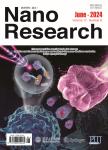Integrin-targeting with peptide-bioconjugated semiconductor-magnetic nanocrystalline heterostructures
Integrin-targeting with peptide-bioconjugated semiconductor-magnetic nanocrystalline heterostructures作者机构:Universita degli Studi di Bari Aldo Moro Dipartimento di Chimica Via Orabona 4 70125 - Bari Italy Istituto per i Processi Chimico-Fisici-CNR UOS Bari Via Orabona 4 70125 - Bari Italy Istituto di Biostrutture e Bioimmagini-CNR Via Mezzocannone 16 80134 - Napoli Italy Universita degli Studi di Bari Aldo Moro Dipartimento di Farmacia - Scienze del Farmaco Via Orabona 4 70125 - Bari Italy Universita degli Studi di BariAIdo Moro Dipartimento di Bioscienze Biotecnologie e Biofarmaceutica Via Orabona 4 70125 - Bari Italy lstituto di Cristallografia-CNR Via Amendola 122/0 70126 Bari Italy
出 版 物:《Nano Research》 (纳米研究(英文版))
年 卷 期:2016年第9卷第3期
页 面:644-662页
核心收录:
学科分类:0710[理学-生物学] 0808[工学-电气工程] 07[理学] 0809[工学-电子科学与技术(可授工学、理学学位)] 08[工学] 071007[理学-遗传学] 0805[工学-材料科学与工程(可授工学、理学学位)] 0702[理学-物理学]
基 金:supported by PRIN 2010-2011 PON R&C 2007–2013 MAATMolecular Nanotechnology for Health and Environment FIRB Futuro in Ricerca FIRB project Nanomax-integrable sensors for pathological biomarkers diagnosis(N-CHEM) Laboratorio Regionale di Sintesi e Caratterizzazione di Nuovi Materiali Organici e Nanostrutturati per Elettronica, Fotonica e Tecnologie Avanzate, National and Sens&Micro LAB
主 题:nanocrystallineheterostructures,photoactive semiconductor,magnetic nanostructure,cyclic RGD peptide,αvβ3 integrin,active targeting
摘 要:Binary asymmetric nanocrystals (BNCs), composed of a photoactive TiO2 nanorod joined with a superparamagnetic γ-Fe203 spherical domain, were embedded in polyethylene glycol modified phospholipid micelle and successfully bioconjugated to a suitably designed peptide containing an RGD motif. BNCs represent a relevant multifunctional nanomaterial, owing to the coexistence of two distinct domains in one particle, characterized by high photoactivity and magnetic properties, that is particularly suited for use as a phototherapy and hyperthermia agent as well as a magnetic probe in biological imaging. We selected the RGD motif in order to target integrin expressed on activated endothelial cells and several types of cancer cells. The prepared RGD-peptide/BNC conjugates, comprehensively monitored by using complementary optical and structural techniques, demon- strated a high stability and uniform dispersibility in biological media. The cytotoxicity of the RGD-peptide/BNC conjugates was studied in vitro. The cellular uptake of RGD-peptide conjugates in the cells, assessed by means of two distinct approaches, namely confocal microscopy analysis and emission spectroscopy determination in cell lysates, displayed selectivity of the RGD-peptide-BNC conjugate for the cw]33 integrin. These RGD-peptide-BNC conjugates have a high potential for theranostic treatment of cancer.



